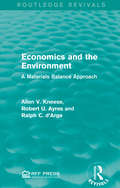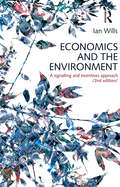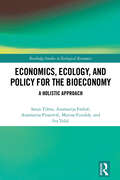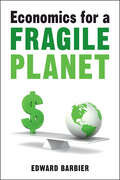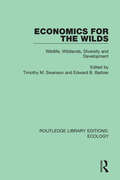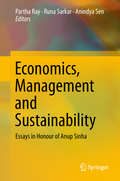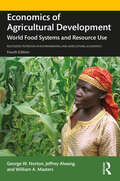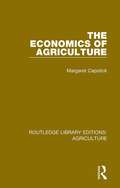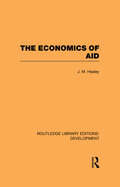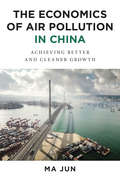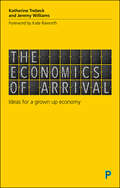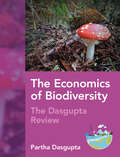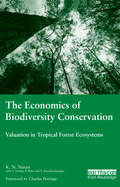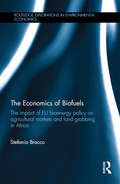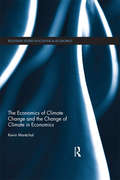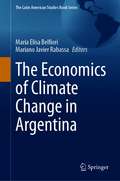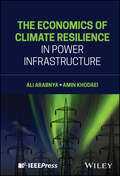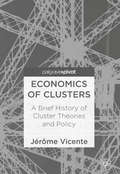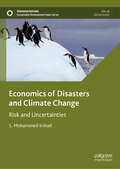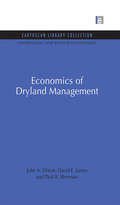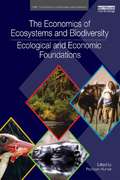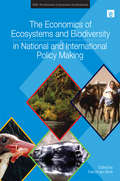- Table View
- List View
Economics and the Challenge of Global Warming
by Charles S. PearsonEconomics and the Challenge of Global Warming is a balanced and comprehensive analysis of the role of economics in confronting global warming, the central environmental issue of the twenty-first century. It avoids a technical exposition in order to reach a wide audience and is up to date in its theoretical and empirical underpinnings. It is addressed to all who have some knowledge of economic concepts and a serious interest in how economics can (and cannot) help in crafting climate policy. The book is organized around three central questions. First, can benefit-cost analysis guide us in setting warming targets? Second, what strategies and policies are cost-effective? Third, and most difficult, can a global agreement be forged between rich and poor, North and South? While economic concepts are foremost in the analysis, they are placed within an accessible ethical and political matrix. The book serves as a primer for the post-Kyoto era.
Economics and the Environment: A Materials Balance Approach (Routledge Revivals)
by Robert U. Ayres Allen V. Kneese Ralph C. d'ArgeThis monograph length report, first published in 1970, originated from a program of research at Resources for the Future that dealt with the management of residuals and of environmental quality. It presents some of the broad concepts that the program was based on and represents the effort to break out of the traditional approach in pollution and policy research, which had treated air, water, and solid waste problems as separate categories. This book will be of interest to students of economics and environmental studies.
Economics and the Environment: A signalling and incentives approach
by Ian WillsCoordinating our use of the earth's natural resources is not easy. Resource users are many, their goals diverse, and their impacts on the environment often uncertain.How we use those resources depends on the signals and incentives we receive, from either the market or our governments. These systems encourage certain uses of natural resources, but they are not perfect. We harm the environment not out of malice, but because we do not know the consequences of our actions, or the incentives for harm are too great to ignore.Economics and the Environment argues that, by lowering the cost and improving the quality of the necessary signals and incentives, we can better reconcile our diverse interests in the environment. It introduces an economic way of thinking about environmental issues, without assuming a background in economics:* how the economy and the environment interact* how resource use is coordinated in ideal market and planned economies* the barriers to ideal signalling and incentives in real markets and real government planning* the economist's tools for dealing with natural resource issues* the uncertainty and complexity of environmental issues: climate change, water rights, air pollution and overharvesting of common resources.This second edition of Economics and the Environment is fully updated and includes new material on sustainability, valuation of environmental changes, the prospects for international cooperation under the Kyoto Protocol and the problems of defining and enforcing measures to protect biodiversity. It offers students in both economics and environmental studies programs a coherent framework for understanding our major environmental problems.'Ian Wills succeeds in providing a fresh perspective . . . a very interesting and informative textbook.'Economic Record
Economics, Ecology, and Policy for the Bioeconomy: A Holistic Approach (Routledge Studies in Ecological Economics)
by Sanja Tišma Anamarija Farkaš Anamarija Pisarović Marina Funduk Iva TolićThis book demonstrates that a holistic approach to the bioeconomy is essential if it is to achieve its full potential in driving economic growth while simultaneously providing ecological, social and technological benefits. Definitions of the ‘bioeconomy’ vary but in general it incorporates the ways in which societies manage and distribute their primary or secondary biological resources for further use in everyday life (e.g. food, materials, and energy). The classical sectors related to the bioeconomy have therefore been agriculture, forestry and aquaculture, now extended to include bioenergy, biofuels, biochemicals, and other processing and service industries. There are also related new concepts such us the blue economy, the green economy, and the circular economy. This book integrates these definitions, sectoral analyses and new concepts into a fully rounded study of the bioeconomy. It is argued that the key aims in the coming years have to be the harmonization of public policies between different sectors, regulation of legislative framework for the bioeconomy, and clear communication of these issues. In particular, the book argues that a strengthening of the monitoring and evaluation of the impacts of the bioeconomy on society is an essential starting point. For this to be effective, appropriate indicators need to be established and defined for the monitoring of the effects of these resilient policies related to bioeconomy and their impact on local and regional development and quality of life. This book will be essential reading for anyone interested in the bioeconomy including students and scholars of ecological economics, environmental economics, sustainability, innovation, and regional development.
Economics for a Fragile Planet: Rethinking Markets, Institutions and Governance
by Edward BarbierIn a world of growing environmental risks and ecological scarcities, ensuring a safe Anthropocene for humankind is essential. Managing an increasingly "fragile" planet requires new thinking on markets, institutions and governance built on five principles: ending the underpricing of nature, fostering collective action, accepting absolute limits, attaining sustainability, and promoting inclusivity. Rethinking economics and policies in this way can help to overcome the global challenges posed by climate change, biodiversity loss, freshwater scarcity, and deteriorating marine and coastal habitats. It requires decoupling wealth creation from environmental degradation through business, policy and financial actions aimed at better stewardship of the biosphere. In this book, renowned environmental economist Edward Barbier offers a blueprint for a greener and more inclusive economy, and outlines the steps we must take now to build a post-COVID world that limits environmental threats while sustaining per capita welfare.
Economics for the Wilds: Wildlife, Wildlands, Diversity and Development (Routledge Library Editions: Ecology #13)
by Timothy M. Swanson Edward B. BarbierOriginally published in 1992 Economics for the Wilds argues that an economics that properly values the resources of the wilds offers the best long-term security for their future. Most of the world’s wilds have, in fact, always been utilized by local societies who have managed their resources sustainably, and one important guarantee for their preservation is therefore the continued participation of those communities and an adequate reward to them for their management. The book looks at the complexity and global nature of the issues, at the application of economics to the wilds and at the policies for their conservation and sustainable management which then result. It also examines specific forms of utilization of wild species and habitats, both sustainable and unsustainable, and including community-based development, tourism, the use of rainforest products, poaching and the impact of conservation on wildlife use. The book concludes that a comprehensive utilization strategy for wild resources is needed to ensure their continued existence and the continued flow of benefits from them.
Economics, Management and Sustainability: Essays In Honour Of Anup Sinha (India Studies in Business and Economics)
by Anindya Sen Runa Sarkar Partha RayThis book presents an eclectic mix of interesting new areas in the domain of economics, management and sustainability. Written by leading experts, it provides valuable food for thought, with essays introducing new lines of research and empirical research papers offering sound research methodology. The book not only provides answers, but also raises numerous interesting questions concerning the areas covered to whet readers’ appetites to learn more. Professor Anup Sinha is a respected teacher and is a great mind with wide-ranging academic interests spanning from economics and sustainability to management. As well as in various other places in India and the US, he has taught at the Indian Institute of Management Calcutta and Presidency College (now a University) Calcutta for almost three decades. To commemorate his contributions, this festschrift presents a collection of essays that are broadly subdivided into four sections: Economic Development; Vulnerabilities and Inclusive Growth; Sustainability and Corporate Governance; and Innovation and Management.
Economics of Agricultural Development: World Food Systems and Resource Use (Routledge Textbooks in Environmental and Agricultural Economics)
by George W. Norton Jeffrey Alwang William A. MastersEconomics of Agricultural Development examines the causes, severity, and effects of poverty, population growth, and malnutrition in developing countries. It discusses potential solutions to these problems, progress made in many countries in recent years, and the implications of globalization for agriculture, poverty, and the environment. Topics covered in the book include: Means for utilizing agricultural surpluses to further overall economic development The sustainability of the natural resource environment Gender issues in relation to agriculture and resource use The contribution of improved technologies to agricultural development The importance of agricultural policies and institutions to development and trade Actions to encourage more rapid agricultural and economic development This new edition reflects the following developments: Growth in environmental challenges due to climate change Continued progress in agricultural and economic development in many low-income countries while other countries and regions are being left behind Continued growth in demand for higher-valued farm products This book is essential reading for undergraduate students seeking to understand the economics of agricultural development and the world food system, including environmental and human consequences, international trade, and capital flows. It contains a wealth of real-world case studies and is accompanied by a website.
The Economics of Agriculture (Routledge Library Editions: Agriculture #11)
by Margaret CapstickFirst published in 1970. The aim of this book is to provide an introduction to the special problems of agriculture in modern economies. The author writes for students of economics who have already acquired the elements of economic theory; no attempt is made, therefore, to explain simple theoretical concepts, but instead these are used in the analysis of some of the main problems of agricultural adjustment. Emphasis is placed on the position of agriculture in the economies of western Europe and of the United States. Sufficient historical background is given to explain the present use of the factors of production in agriculture and the way in which this use and policies of agricultural support vary from one country to another. Agricultural support policies are discussed with reference to their effect on consumers, producers and on rural society.
The Economics of Aid (Routledge Library Editions: Development)
by J. M. HealeyFirst published in 1971, this reissue considers the main aspects of foreign aid to developing countries in terms of economic concepts and principles. The author gives an economic definition of aid and considers the motives for giving aid and the principles on which it may be allocated. He looks at the effect on the economic growth of developing countries of both the aid given and the need to repay the debt, and the effect on trade patterns and resource allocation of tying aid to one particular project, or one source of goods. While economic analysis is only a first step in providing a basis for policy decisions on foreign aid, Dr Healey shows that many issues can be clarified by looking at them from the economists’ point of view.
The Economics of Air Pollution in China: Achieving Better and Cleaner Growth
by Ma JunSuffocating smog regularly envelops Chinese metropolises from Beijing to Shanghai, clouding the future prospect of China's growth sustainability. Air pollutants do not discriminate between the rich and the poor, the politician and the "average Joe." They put everyone's health and economic prosperity at risk, creating future costs that are difficult to calculate. Yet many people, including some in China, are concerned that addressing environmental challenges will jeopardize economic growth.In The Economics of Air Pollution in China, leading Chinese economist Ma Jun makes the case that the trade-off between growth and environment is not inevitable. In his ambitious proposal to tackle severe air pollution and drastically reduce the level of so-called PM 2.5 particles-microscopic pollutants that lodge deeply in lungs-Ma Jun argues that in targeting pollution, China has a real opportunity to undertake significant structural economic reforms that would support long-term growth. Rooted in rigorous analyses and evidence-based projections, Ma Jun's "big bang" proposal aims to mitigate pollution and facilitate a transition to a greener and more sustainable growth model.
The Economics of Air Pollution in China: Achieving Better and Cleaner Growth
by Jun MaSuffocating smog regularly envelops Chinese metropolises from Beijing to Shanghai, clouding the future prospect of China's growth sustainability. Air pollutants do not discriminate between the rich and the poor, the politician and the "average Joe." They put everyone's health and economic prosperity at risk, creating future costs that are difficult to calculate. Yet many people, including some in China, are concerned that addressing environmental challenges will jeopardize economic growth. In The Economics of Air Pollution in China, leading Chinese economist Ma Jun makes the case that the trade-off between growth and environment is not inevitable. In his ambitious proposal to tackle severe air pollution and drastically reduce the level of so-called PM 2.5 particles—microscopic pollutants that lodge deeply in lungs—Ma Jun argues that in targeting pollution, China has a real opportunity to undertake significant structural economic reforms that would support long-term growth. Rooted in rigorous analyses and evidence-based projections, Ma Jun's "big bang" proposal aims to mitigate pollution and facilitate a transition to a greener and more sustainable growth model.
The Economics of Arrival: Ideas for a Grown-Up Economy
by Jeremy Williams Katherine TrebeckWhat do we want from economic growth? What sort of a society are we aiming for? In everyday economics, there is no such thing as enough, or too much, growth. Yet in the world’s most developed countries, growth has already brought unrivalled prosperity: we have ‘arrived’. More than that, through debt, inequality, climate change and fractured politics, the fruits of growth may rot before everyone has a chance to enjoy them. It’s high time to ask where progress is taking us, and are we nearly there yet? In fact, Trebeck and Williams claim in this ground-breaking book, the challenge is now to make ourselves at home with this wealth, to ensure, in the interests of equality, that everyone is included. They explore the possibility of ‘Arrival’, urging us to move from enlarging the economy to improving it, and the benefits this would bring for all.
The Economics of Biodiversity: The Dasgupta Review
by Partha DasguptaWe are part of Nature, not separate from it. We rely on Nature to provide us with food, water and shelter; regulate our climate and disease; maintain nutrient cycles and oxygen production; and provide us with spiritual fulfilment and opportunities for recreation and recuperation, which can enhance our health and well-being. Nature's constituents such as ecosystems and the biodiversity that are embodied in them are therefore assets. Yet Nature is more than an economic good: many recognise its intrinsic worth and argue that it has moral worth too. This landmark report explains the current state of play in relation to biodiversity loss and outlines a sustainable path to deal with this problem, one that will require us to change how we think, act and measure success. The report was originally commissioned and published by HM Treasury. This title is also available as Open Access on Cambridge Core.
The Economics of Biodiversity Conservation: Valuation in Tropical Forest Ecosystems
by K.N NinanEconomic valuation of biodiversity and ecosystem services is possibly the most powerful tool for halting the loss of biodiversity while maintaining incomes and livelihoods. Yet rarely have such approaches been applied to tropical forest ?hotspots?, which house the vast majority of the planets plant and animal species. This ground-breaking work is the most comprehensive and detailed examination of the economics of environmental valuation and biodiversity conservation to date. Focusing on the Western Ghats of India, one of the top biodiversity hotspots in the world, this volume looks at a cross-section of local communities living within or near sanctuaries and reserve forests such as coffee growers, indigenous people and farmers-cum-pastoralists to assess the use and non-use values that people derive from tropical forests. It also looks at the extent of their dependence on forests for various goods and services, and examines their perceptions and attitudes towards biodiversity conservation and wildlife protection. The book concludes with an assessment of the institutional alternatives and policies for promoting biodiversity conservation through economic valuation methods. Related titles Economics for Collaborative Environmental Management (2005) 1-84407-095-6
The Economics of Biofuels: The impact of EU bioenergy policy on agricultural markets and land grabbing in Africa (Routledge Explorations in Environmental Economics)
by Stefania BraccoBiofuels are a renewable source of energy used mainly for transportation. They link together food, energy and natural resources sectors, and involve ecological, social and inequality issues. They are an emblematic example of the interactions between economic, environmental, social and political decisions and, as a recent and complex issue, require updated and detailed information to be understood. This book aims to shed light on several economic, social and environmental issues connected to biofuel production and policies. The Economics of Biofuels adopts detailed descriptions, rigorous data analysis and precise econometric methods to estimate the effects of biofuel on different socio-economic factors, avoiding complicated and sometimes ineffective models based on context-specific parameters. In particular, the book focuses on the impact of bioenergy policy on biocommodity production and trade, and on the related phenomenon of land acquisitions to grow biofuel commodities. The book’s main findings are derived by an original and unique dataset collecting information on the investors acquiring land in Africa and on the voluntary standard, certification and labelling schemes adopted by them as Corporate Social Responsibility (CSR) strategy. The analysis links together in an original way public and private initiatives to make biofuel sustainable. Therefore, this book represents an improvement in the understanding of biofuel production and policy’s sustainability. This book is of interest to those who study environmental economics, agricultural economics and sustainable development. It is also suitable for those in the renewable energy sector, with a particular focus on biofuel sustainability.
The Economics of Climate Change
by Nicholas SternThere is now clear scientific evidence that emissions from economic activity, particularly the burning of fossil fuels for energy, are causing changes to the Earth's climate. A sound understanding of the economics of climate change is needed in order to underpin an effective global response to this challenge. The Stern Review is an independent, rigourous and comprehensive analysis of the economic aspects of this crucial issue. It has been conducted by Sir Nicholas Stern, Head of the UK Government Economic Service, and a former Chief Economist of the World Bank. The Economics of Climate Change will be invaluable for all students of the economics and policy implications of climate change, and economists, scientists and policy makers involved in all aspects of climate change.
The Economics of Climate Change and the Change of Climate in Economics
by Kevin MaréchalClimate change is without question the single most important issue the world faces over the next hundred years. The most recent scientific data have led to the conclusion that the globally averaged net effect of human activities since 1750 has been one of warming and that continued greenhouse gas emissions at or above current rates would cause this process to continue to the severe detriment of our environment. This unequivocal link between climate change and human activity requires an urgent, world-wide shift towards a low carbon economy and coordinated policies and measures to manage this transition. The starting point and core idea of this book is the long-held observation that thethreat of climate change calls for a change of climate in economics. Inherent characteristics of the climate problem including complexity, irreversibility and deep uncertainty challenge core economic assumptions and mainstream economic theory appears inappropriately equipped to deal with this crucial issue. Kevin Maréchal shows how themes and approaches from evolutionary and ecological economics can be united to provide a theoretical framework that is better suited to tackle the problem.
The Economics of Climate Change in Argentina (The Latin American Studies Book Series)
by Maria Elisa Belfiori Mariano Javier RabassaIn this volume, the contributors discuss some of the most remarkable global warming effects in Argentina and examine policies that Latin American countries could follow to achieve their individual climate goals. Climate change is one of the most pressing issues today. However, after many years of climate negotiations, the world has failed to introduce a common global policy. Differences in countries' climate agendas have led to unsuccessful efforts. Countries willing to pursue a climate policy have sought alternative strategies to mitigate and adapt to global warming's consequences within their jurisdiction. In this context, Latin American countries' role in shaping the regional climate agenda is yet to be explored. The book covers some papers from the well-received "First Workshop on Environmental Economics and Energy" in Argentina. Using data from Argentina, the contributors analyze the effects of global warming on agricultural yields and the impact of extreme weather on human health. From a global perspective, the contributors also describe the interactions between a reduction in carbon emissions, carbon emissions intensity, and economic growth; the role that trade policies can play to reduce carbon emissions; and the paradoxes that arise from promoting renewable energies in the region. The contributors also address the relationship between sustainability and economic growth; the private sector's role in shaping policies and providing sustainable solutions; and the Latin American challenges for the next generation. The book will be of interest to policy-makers, academics, researchers, and professionals worldwide working in climate change impacts and policy. It will also appeal to a general audience interested in climate change economics, its consequences, and the steps that countries in Latin America can take to move forward.
The Economics of Climate Resilience in Power Infrastructure
by Ali Arabnya Amin KhodaeiFull-scope economic perspectives on planning, operations management, and maintenance of climate resilience building measures in power infrastructure The Economics of Climate Resilience in Power Infrastructure sheds light on the engineering economics of climate adaptation in electric power infrastructure by covering the relevant decision-making processes involved in managing risk and resilience in these systems. The book offers a system-level perspective along with detailed modeling of the most pressing resilience issues, while also providing detailed numerical examples on small test systems throughout the text to help readers see the outcomes of models. The book starts with an introduction to risk management and the techno-economic considerations for resilience building measures in power systems. Next, economic concepts and mechanisms for managing climate risk in power systems are introduced. Afterward, an economic model for resilience investment in these systems against climate shocks is presented. The authors then discuss an economic asset management model for long-term resilience building in critical infrastructure assets. Subsequently, an economic model for operations management during disasters is proposed, followed by a model for post-disaster restoration. Written by a pair of distinguished thought leaders, the book explores other topics such as: Microgrid applications for decentralization, along with an economic model for resilience-oriented microgrid operations A deep defense framework for climate risk management in power systems, along with other factors influencing their operational and financial resilience Essential climate risk financing mechanisms and techno-economic factors in managing risk and resilience in the face of wildfires, heat waves, and hurricanes Steps for utility and infrastructure owners to recover from climate shocks and natural disasters, for the benefit of shareholders, ratepayers, and policymakers The Economics of Climate Resilience in Power Infrastructure is an essential resource on the subject for industry practitioners, R&D engineers, infrastructure planners, and graduate students seeking to incorporate the economics of resilience with engineering solutions to streamline the success of climate adaptation measures in the power and energy industry.
Economics of Clusters: A Brief History of Cluster Theories and Policy
by Jérôme VicenteWhen we talk about clusters, it's the fabulous destiny of Silicon Valley that first comes to mind – the place where entrepreneurs and policymakers alike flock. But do we really understand the complex mechanics of these clusters? What tools can economics and other related disciplines use to analyze their performance? When it comes to spending taxpayer money to support cluster development, do benefits actually exceed costs? This book provides a synthesis of cluster theory and presents methodologies to analyze their structure and performance. It also contains insights into how to renew regional innovation policy.The French edition of this volume was granted Best Book in Economics 2016 by The French Association of Economics (AFSE)
Economics of Disasters and Climate Change: Risk and Uncertainties (Sustainable Development Goals Series)
by S. Mohammed IrshadThis book discusses the theory, method, and practice of risk economics and also examines climate change and disaster's theoretical and practical implications on capital formation and accumulation in the contemporary economic system. It explores the theoretical and practical challenges of engaging with climate and disaster risk in the changing context of capital investments and market expansion. It explains the emergence of an at-risk society and its interface with economic decision-making. The critical issue the book explores is the implication of certainty over the return period of risk and its influence on the economic behaviour of the state and market institutions. Risk sharing and governing economic risks in the context of financial capitalism is a major theoretical issue the book engages with. It offers a new conceptual framework to see how risk economics evolves out of increasing climate and disaster risks and a counter-discourse on the mainstream economic theoretical standpoint on capital and explains the economics of capital replacement in vulnerable social systems. These broader perspectives will be valuable to economists, researchers, experts in disaster and climate risk, corporate professionals, economics educators, specialists in financial economics, and those involved in development policy-making. This book offers a detailed discussion of risk mitigation and its interface with sustainable development goals including climate action.
Economics of Dryland Management: Economics Of Dryland Management (Environmental and Resource Economics Set)
by John A. Dixon David E. James Paul B. ShermanWe have always had land in which the agricultural productivity is limited because there is not enough moisture. Systems of farming and burning often degrade dryland further until it is desert. Today, however, the problem is becoming much more serious. Over 20 per cent of the world's population lives in dryland areas, and unless action is taken drylands will increase dramatically. This book focuses on the people who live and .farm in the drylands, their use of land resources and the economic returns from their decisions. In a clear and thorough economic appraisal, the authors show how it is still possible to arrest the problem. Originally published in 1989
The Economics of Ecosystems and Biodiversity: Ecological And Economic Foundations (TEEB - The Economics of Ecosystems and Biodiversity)
by Pushpam KumarHuman well-being relies critically on ecosystem services provided by nature. Examples include water and air quality regulation, nutrient cycling and decomposition, plant pollination and flood control, all of which are dependent on biodiversity. They are predominantly public goods with limited or no markets and do not command any price in the conventional economic system, so their loss is often not detected and continues unaddressed and unabated. This in turn not only impacts human well-being, but also seriously undermines the sustainability of the economic system. It is against this background that TEEB: The Economics of Ecosystems and Biodiversity project was set up in 2007 and led by the United Nations Environment Programme to provide a comprehensive global assessment of economic aspects of these issues. This book, written by a team of international experts, represents the scientific state of the art, providing a comprehensive assessment of the fundamental ecological and economic principles of measuring and valuing ecosystem services and biodiversity, and showing how these can be mainstreamed into public policies. This volume and subsequent TEEB outputs will provide the authoritative knowledge and guidance to drive forward the biodiversity conservation agenda for the next decade.
The Economics of Ecosystems and Biodiversity in National and International Policy Making (TEEB - The Economics of Ecosystems and Biodiversity)
by Patrick Ten BrinkThe Economics of Ecosystems and Biodiversity (TEEB) study is a major international initiative drawing attention to local, national and global economic benefits of biodiversity, to highlight the growing costs of biodiversity loss and ecosystem degradation, the benefits of investing in natural capital, and to draw together expertise from the fields of science, economics and policy to enable practical actions. Drawing on a team of more than one hundred authors and reviewers, this book demonstrates the value of ecosystems and biodiversity to the economy, society and individuals. It underlines the urgency of strategic policy making and action at national and international levels, and presents a rich evidence base of policies and instruments in use around the world and a wide range of innovative solutions. It highlights the need for new public policy to reflect the appreciation that public goods and social benefits are often overlooked and that we need a transition to decision making which integrates the many values of nature across policy sectors. It explores the range of instruments to reward those offering ecosystem service benefits, such as water provision and climate regulation. It looks at fiscal and regulatory instruments to reduce the incentives of those running down our natural capital, and at reforming subsidies such that they respond to current and future priorities. The authors also consider two major areas of investment in natural capital - protected areas and investment in restoration. Overall the book underlines the needs and ways to transform our approach to natural capital, and demonstrates how we can practically take into account the value of ecosystems and biodiversity in policy decisions - at national and international levels - to promote the protection of our environment and contribute to a sustainable economy and to the wellbeing of societies.

